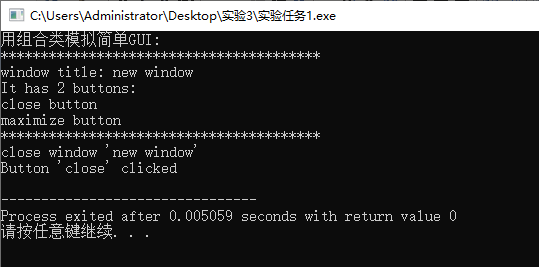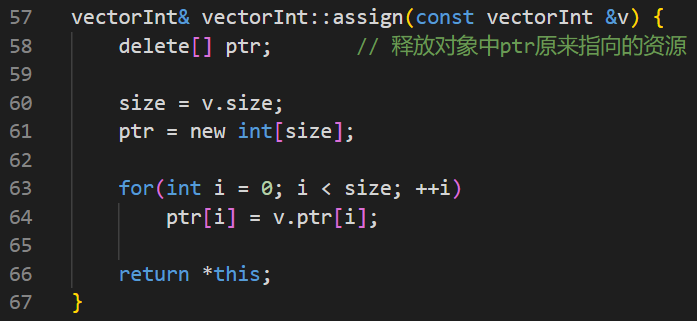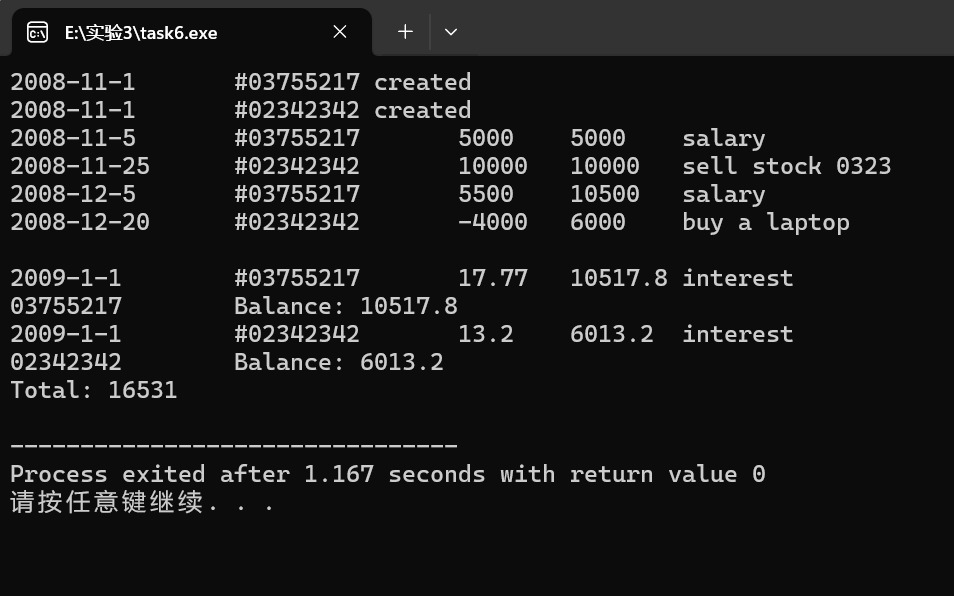实验3 类和对象_基础编程2
实验任务1:
代码:

1 #pragma once 2 3 #include <iostream> 4 #include <string> 5 6 using std::string; 7 using std::cout; 8 9 // 按钮类 10 class Button { 11 public: 12 Button(const string &text); 13 string get_label() const; 14 void click(); 15 16 private: 17 string label; 18 }; 19 20 Button::Button(const string &text): label{text} { 21 } 22 23 inline string Button::get_label() const { 24 return label; 25 } 26 27 void Button::click() { 28 cout << "Button '" << label << "' clicked\n"; 29 }

1 #pragma once 2 #include "button.hpp" 3 #include <vector> 4 #include <iostream> 5 6 using std::vector; 7 using std::cout; 8 using std::endl; 9 10 // 窗口类 11 class Window{ 12 public: 13 Window(const string &win_title); 14 void display() const; 15 void close(); 16 void add_button(const string &label); 17 18 private: 19 string title; 20 vector<Button> buttons; 21 }; 22 23 Window::Window(const string &win_title): title{win_title} { 24 buttons.push_back(Button("close")); 25 } 26 27 inline void Window::display() const { 28 string s(40, '*'); 29 30 cout << s << endl; 31 cout << "window title: " << title << endl; 32 cout << "It has " << buttons.size() << " buttons: " << endl; 33 for(const auto &i: buttons) 34 cout << i.get_label() << " button" << endl; 35 cout << s << endl; 36 } 37 38 void Window::close() { 39 cout << "close window '" << title << "'" << endl; 40 buttons.at(0).click(); 41 } 42 43 void Window::add_button(const string &label) { 44 buttons.push_back(Button(label)); 45 }

1 #include "window.hpp" 2 #include <iostream> 3 4 using std::cout; 5 using std::cin; 6 7 void test() { 8 Window w1("new window"); 9 w1.add_button("maximize"); 10 w1.display(); 11 w1.close(); 12 } 13 14 int main() { 15 cout << "用组合类模拟简单GUI:\n"; 16 test(); 17 }
运行测试结果截图:

问题1:这个模拟简单GUI的示例代码中,自定义了几个类?使用到了标准库的哪几个类?,哪些
类和类之间存在组合关系?
答:自定义了两个类:Button按钮类和Window窗口类。
使用到的标准库类:std::string用于储存字符串和std::vector用于存储动态数组。
window类中组合了Button类。具体看就是Window类里面有std::vector<Button>成员,用于存储窗口中的按钮。
问题2:在自定义类Button和Window中,有些成员函数定义时加了const, 有些设置成了inline。如
果你是类的设计者,目前那些没有加const或没有设置成inline的,适合添加const,适合设置成
inline吗?陈述你的答案和理由。
答:自定义类Button类中:get_label()适合加const,因为这个函数不会修改任何成员变量,只读取。click()不适合加const,因为这个函数可能会修改成员变量或状态。
自定义类Window类中:display()适合加const,因为这个函数不会修改任何成员变量,只读取和显示。close()不适合加const,因为这个函数可能会修改成员变量或状态。add_button()不适合加const,因为这个函数会修改成员变量,即向vector中添加元素。
关于设置成inline:inline通常用于小型、频繁调用的函数,以减少函数调用的开销。get_label()和display()可以考虑设置为inline,因为他们相对较小且可能被频繁调用。
问题3:类Window的定义中,有这样一行代码,其功能是?

答:创建一个std::string类型的对象s,并初始化它为一个包含40个字符“*”的字符串。
实验任务2:
代码:

1 #include <iostream> 2 #include <vector> 3 4 using namespace std; 5 6 void output1(const vector<int> &v) { 7 for(auto &i: v) 8 cout << i << ", "; 9 cout << "\b\b \n"; 10 } 11 12 void output2(const vector<vector<int>> v) { 13 for(auto &i: v) { 14 for(auto &j: i) 15 cout << j << ", "; 16 cout << "\b\b \n"; 17 } 18 } 19 20 void test1() { 21 vector<int> v1(5, 42); 22 const vector<int> v2(v1); 23 24 v1.at(0) = -999; 25 cout << "v1: "; output1(v1); 26 cout << "v2: "; output1(v2); 27 cout << "v1.at(0) = " << v1.at(0) << endl; 28 cout << "v2.at(0) = " << v2.at(0) << endl; 29 } 30 31 void test2() { 32 vector<vector<int>> v1{{1, 2, 3}, {4, 5, 6, 7}}; 33 const vector<vector<int>> v2(v1); 34 35 v1.at(0).push_back(-999); 36 cout << "v1: \n"; output2(v1); 37 cout << "v2: \n"; output2(v2); 38 39 vector<int> t1 = v1.at(0); 40 cout << t1.at(t1.size()-1) << endl; 41 42 const vector<int> t2 = v2.at(0); 43 cout << t2.at(t2.size()-1) << endl; 44 } 45 46 int main() { 47 cout << "测试1:\n"; 48 test1(); 49 50 cout << "\n测试2:\n"; 51 test2(); 52 }
运行结果截图:

问题:
问题1:测试1模块中,这三行代码的功能分别是?

答:第一行:创建了一个名为 v1 的 vector<int> 对象,包含5个初始化为42的整数。
第二行:创建了另一个名为 v2 的 vector<int> 对象,它是 v1 的深复制,意味着 v2 中的元素是 v1 中元素的副本。
第三行:修改了 v1 中第一个元素的值。
问题2:测试2模块中,这三行代码的功能分别是?

答:第一行代码创建了一个名为 v1 的二维 vector 对象,包含两个 vector<int> 对象。
第二行代码创建了另一个名为 v2 的二维 vector 对象,它是 v1 的深复制。
第三行代码在 v1 的第一个 vector<int> 对象末尾添加了一个新元素-999。
问题3:测试2模块中,这四行代码的功能分别是?

答:第一行代码将 v1 的第一个 vector<int> 对象复制到一个新的 vector<int> 对象 t1 。
第二行代码输出 t1 的最后一个元素的值。
第三行代码将 v2 的第一个 vector<int> 对象复制到一个新的 vector<int> 对象 t2 。
第四行代码输出 t2 的最后一个元素的值。
问题4:根据执行结果,反向分析、推断:
① 标准库模板类vector内部封装的复制构造函数,其实现机制是深复制还是浅复制?
② 模板类vector的接口at(), 是否至少需要提供一个const成员函数作为接口?
答:1.深复制。(根据测试1和测试2的结果,我们可以看到 v2 是 v1 的深复制。在测试1中,修改 v1 的第一个元素并不影响 v2 ,这表明 v2 中的元素是 v1 中元素的独立副本。在测试2中,向 v1.at(0) 添加元素并不影响 v2.at(0) ,这也表明 v2 是 v1 的深复制。)
2.是。
实验任务3
代码:

1 #pragma once 2 3 #include <iostream> 4 #include <cassert> 5 6 using std::cout; 7 using std::endl; 8 9 // 动态int数组对象类 10 class vectorInt{ 11 public: 12 vectorInt(int n); 13 vectorInt(int n, int value); 14 vectorInt(const vectorInt &vi); 15 ~vectorInt(); 16 17 int& at(int index); 18 const int& at(int index) const; 19 20 vectorInt& assign(const vectorInt &v); 21 int get_size() const; 22 23 private: 24 int size; 25 int *ptr; // ptr指向包含size个int的数组 26 }; 27 28 vectorInt::vectorInt(int n): size{n}, ptr{new int[size]} { 29 } 30 31 vectorInt::vectorInt(int n, int value): size{n}, ptr{new int[size]} { 32 for(auto i = 0; i < size; ++i) 33 ptr[i] = value; 34 } 35 36 vectorInt::vectorInt(const vectorInt &vi): size{vi.size}, ptr{new int[size]} { 37 for(auto i = 0; i < size; ++i) 38 ptr[i] = vi.ptr[i]; 39 } 40 41 vectorInt::~vectorInt() { 42 delete [] ptr; 43 } 44 45 const int& vectorInt::at(int index) const { 46 assert(index >= 0 && index < size); 47 48 return ptr[index]; 49 } 50 51 int& vectorInt::at(int index) { 52 assert(index >= 0 && index < size); 53 54 return ptr[index]; 55 } 56 57 vectorInt& vectorInt::assign(const vectorInt &v) { 58 delete[] ptr; // 释放对象中ptr原来指向的资源 59 60 size = v.size; 61 ptr = new int[size]; 62 63 for(int i = 0; i < size; ++i) 64 ptr[i] = v.ptr[i]; 65 66 return *this; 67 } 68 69 int vectorInt::get_size() const { 70 return size; 71 }

1 #include "vectorInt.hpp" 2 #include <iostream> 3 4 using std::cin; 5 using std::cout; 6 7 void output(const vectorInt &vi) { 8 for(auto i = 0; i < vi.get_size(); ++i) 9 cout << vi.at(i) << ", "; 10 cout << "\b\b \n"; 11 } 12 13 14 void test1() { 15 int n; 16 cout << "Enter n: "; 17 cin >> n; 18 19 vectorInt x1(n); 20 for(auto i = 0; i < n; ++i) 21 x1.at(i) = i*i; 22 cout << "x1: "; output(x1); 23 24 vectorInt x2(n, 42); 25 vectorInt x3(x2); 26 x2.at(0) = -999; 27 cout << "x2: "; output(x2); 28 cout << "x3: "; output(x3); 29 } 30 31 void test2() { 32 const vectorInt x(5, 42); 33 vectorInt y(10, 0); 34 35 cout << "y: "; output(y); 36 y.assign(x); 37 cout << "y: "; output(y); 38 39 cout << "x.at(0) = " << x.at(0) << endl; 40 cout << "y.at(0) = " << y.at(0) << endl; 41 } 42 43 int main() { 44 cout << "测试1: \n"; 45 test1(); 46 47 cout << "\n测试2: \n"; 48 test2(); 49 }
运行结果:

问题:
问题1:vectorInt类中,复制构造函数(line14)的实现,是深复制还是浅复制?

答:深复制(分配了新内存且元素值是逐个复制的,line36)
问题2:vectorInt类中,这两个at()接口,如果返回值类型改成int而非int&(相应地,实现部分也 同步修改),测试代码还能正确运行吗?如果把line18返回值类型前面的const掉,针对这个测试 代码,是否有潜在安全隐患?尝试分析说明。

答:不能。改后意味着函数返回的是元素的副本而不是引用,导致无法通过at()接口修改vectorInt中实际元素值,因为返回的是值的副本,而且测试代码中有通过at()修改元素值的操作。
有潜在安全隐患。允许了非const版本的at()函数修改对象,设计预想偏差。
问题3:vectorInt类中,assign()接口,返回值类型可以改成vectorInt(即返回对象而不是引用)吗?你的结论及原因分析。

答:不可以,应该保持为vectorInt&以保持一致性。可能导致在需要引用时返回了对象而不是引用,而且assign()用于就地修改对象,返回对象会改变语义,使函数行为与预期不符。
实验任务4:
代码:

1 #pragma once 2 3 #include <iostream> 4 #include <cassert> 5 6 using std::cout; 7 using std::endl; 8 9 // 类Matrix的声明 10 class Matrix { 11 public: 12 Matrix(int n, int m); // 构造函数,构造一个n*m的矩阵, 初始值为value 13 Matrix(int n); // 构造函数,构造一个n*n的矩阵, 初始值为value 14 Matrix(const Matrix &x); // 复制构造函数, 使用已有的矩阵X构造 15 ~Matrix(); 16 17 void set(const double *pvalue); // 用pvalue指向的连续内存块数据按行为矩阵赋值 18 void clear(); // 把矩阵对象的值置0 19 20 const double& at(int i, int j) const; // 返回矩阵对象索引(i,j)的元素const引用 21 double& at(int i, int j); // 返回矩阵对象索引(i,j)的元素引用 22 23 int get_lines() const; // 返回矩阵对象行数 24 int get_cols() const; // 返回矩阵对象列数 25 26 void display() const; // 按行显示矩阵对象元素值 27 28 private: 29 int lines; // 矩阵对象内元素行数 30 int cols; // 矩阵对象内元素列数 31 double *ptr; 32 }; 33 34 // 类Matrix的实现:待补足 35 // matrix.cpp 36 #include "matrix.hpp" 37 38 Matrix::Matrix(int n, int m) : lines(n), cols(m), ptr(new double[n * m]) { 39 std::fill(ptr, ptr + n * m, 0); // 初始化为0 40 } 41 42 Matrix::Matrix(int n) : Matrix(n, n) {} 43 44 Matrix::Matrix(const Matrix &x) : lines(x.lines), cols(x.cols), ptr(new double[x.lines * x.cols]) { 45 std::copy(x.ptr, x.ptr + x.lines * x.cols, ptr); 46 } 47 48 Matrix::~Matrix() { 49 delete[] ptr; 50 } 51 52 void Matrix::set(const double *pvalue) { 53 std::copy(pvalue, pvalue + lines * cols, ptr); 54 } 55 56 void Matrix::clear() { 57 std::fill(ptr, ptr + lines * cols, 0); 58 } 59 60 const double& Matrix::at(int i, int j) const { 61 assert(i >= 0 && i < lines && j >= 0 && j < cols); 62 return ptr[i * cols + j]; 63 } 64 65 double& Matrix::at(int i, int j) { 66 assert(i >= 0 && i < lines && j >= 0 && j < cols); 67 return ptr[i * cols + j]; 68 } 69 70 int Matrix::get_lines() const { 71 return lines; 72 } 73 74 int Matrix::get_cols() const { 75 return cols; 76 } 77 78 void Matrix::display() const { 79 for (int i = 0; i < lines; ++i) { 80 for (int j = 0; j < cols; ++j) { 81 cout << ptr[i * cols + j] << " "; 82 } 83 cout << endl; 84 } 85 }

1 #include "matrix.hpp" 2 #include <iostream> 3 #include <cassert> 4 5 using std::cin; 6 using std::cout; 7 using std::endl; 8 9 10 const int N = 1000; 11 12 // 输出矩阵对象索引为index所在行的所有元素 13 void output(const Matrix &m, int index) { 14 assert(index >= 0 && index < m.get_lines()); 15 16 for(auto j = 0; j < m.get_cols(); ++j) 17 cout << m.at(index, j) << ", "; 18 cout << "\b\b \n"; 19 } 20 21 22 void test1() { 23 double x[1000] = {1, 2, 3, 4, 5, 6, 7, 8, 9}; 24 25 int n, m; 26 cout << "Enter n and m: "; 27 cin >> n >> m; 28 29 Matrix m1(n, m); // 创建矩阵对象m1, 大小n×m 30 m1.set(x); // 用一维数组x的值按行为矩阵m1赋值 31 32 Matrix m2(m, n); // 创建矩阵对象m1, 大小m×n 33 m2.set(x); // 用一维数组x的值按行为矩阵m1赋值 34 35 Matrix m3(2); // 创建一个2×2矩阵对象 36 m3.set(x); // 用一维数组x的值按行为矩阵m4赋值 37 38 cout << "矩阵对象m1: \n"; m1.display(); cout << endl; 39 cout << "矩阵对象m2: \n"; m2.display(); cout << endl; 40 cout << "矩阵对象m3: \n"; m3.display(); cout << endl; 41 } 42 43 void test2() { 44 Matrix m1(2, 3); 45 m1.clear(); 46 47 const Matrix m2(m1); 48 m1.at(0, 0) = -999; 49 50 cout << "m1.at(0, 0) = " << m1.at(0, 0) << endl; 51 cout << "m2.at(0, 0) = " << m2.at(0, 0) << endl; 52 cout << "矩阵对象m1第0行: "; output(m1, 0); 53 cout << "矩阵对象m2第0行: "; output(m2, 0); 54 } 55 56 int main() { 57 cout << "测试1: \n"; 58 test1(); 59 60 cout << "测试2: \n"; 61 test2(); 62 }
运行结果:

实验任务5:
代码:

1 // user.hpp 2 #pragma once 3 #include <iostream> 4 #include <string> 5 6 class User { 7 private: 8 std::string name; // 用户名 9 std::string password; // 密码 10 std::string email; // 邮箱 11 12 public: 13 // 构造函数 14 User(const std::string& name = "", const std::string& password = "123456", const std::string& email = "") 15 : name(name), password(password), email(email) {} 16 17 // 设置邮箱 18 void set_email() { 19 std::cout << "Please enter your email: "; 20 std::getline(std::cin, email); 21 // 简单合法性校验(是否包括@) 22 while (email.find('@') == std::string::npos) { 23 std::cout << "Invalid email, please try again: "; 24 std::getline(std::cin, email); 25 } 26 } 27 28 // 修改密码 29 void change_password() { 30 std::string old_password; 31 int attempts = 0; 32 while (attempts < 3) { 33 std::cout << "Please enter your old password: "; 34 std::getline(std::cin, old_password); 35 if (old_password == password) { 36 std::cout << "Please enter your new password: "; 37 std::getline(std::cin, password); 38 return; 39 } else { 40 std::cout << "Incorrect password, please try again." << std::endl; 41 attempts++; 42 } 43 } 44 std::cout << "Too many failed attempts, please try again later." << std::endl; 45 } 46 47 // 打印用户信息 48 void display() const { 49 std::string masked_password(password.size(), '*'); 50 std::cout << "Name: " << name << "\nPassword: " << masked_password << "\nEmail: " << email << std::endl; 51 } 52 };

1 #include "user.hpp" 2 #include <iostream> 3 #include <vector> 4 #include <string> 5 6 using std::cin; 7 using std::cout; 8 using std::endl; 9 using std::vector; 10 using std::string; 11 12 void test() { 13 vector<User> user_lst; 14 15 User u1("Alice", "2024113", "Alice@hotmail.com"); 16 user_lst.push_back(u1); 17 cout << endl; 18 19 User u2("Bob"); 20 u2.set_email(); 21 u2.change_password(); 22 user_lst.push_back(u2); 23 cout << endl; 24 25 User u3("Hellen"); 26 u3.set_email(); 27 u3.change_password(); 28 user_lst.push_back(u3); 29 cout << endl; 30 31 cout << "There are " << user_lst.size() << " users. they are: " << endl; 32 for(auto &i: user_lst) { 33 i.display(); 34 cout << endl; 35 } 36 } 37 38 int main() { 39 test(); 40 }
运行结果:

实验任务6:

1 #ifndef __DATE_H__ 2 #define __DATE_H__ 3 4 class Date { 5 private: 6 int year; //年 7 int month; //月 8 int day; //日 9 int totalDays; //该日期是从公元元年1月1日开始的第几天 10 public: 11 Date(int year, int month, int day); //用年、月、日构造日期 12 int getYear() const { return year; } 13 int getMonth() const { return month; } 14 int getDay() const { return day; } 15 int getMaxDay() const; 16 bool isLeapYear() const { 17 return year % 4 == 0 && year % 100 != 0 || year % 400 == 0; 18 } 19 void show() const; 20 //计算两个日期之间相差多少天 21 int distance(const Date& date) const { 22 return totalDays - date.totalDays; 23 } 24 }; 25 #endif

1 #include "date.h" 2 #include <iostream> 3 #include <cstdlib> 4 using namespace std; 5 6 //命名空间使下面的定义只在当前文件中有效 7 namespace { 8 //存储平年中的某个月1日之前有多少天,为便于getMaxDay函数的实现,该数组多出一项 9 const int DAYS_BEFORE_MONTH[] = { 0, 31, 59, 90, 120, 151, 181, 212, 243, 273, 304, 334, 365 }; 10 } 11 12 Date::Date(int year, int month, int day) : year(year), month(month), day(day) { 13 if (day <= 0 || day > getMaxDay()) { 14 cout << "Invalid date."; 15 show(); 16 cout << endl; 17 exit(1); 18 } 19 int years = year - 1; 20 totalDays = years * 365 + years / 4 - years / 100 + years / 400 21 + DAYS_BEFORE_MONTH[month-1] + day; 22 if (isLeapYear() && month > 2) totalDays++; 23 } 24 25 26 int Date::getMaxDay()const { 27 if (isLeapYear() && month == 2) { 28 return 29; 29 } 30 else { 31 return DAYS_BEFORE_MONTH[month] - DAYS_BEFORE_MONTH[month - 1]; 32 } 33 } 34 35 void Date::show() const { 36 cout << getYear() << '-' << getMonth() << '-' << getDay(); 37 }

1 #ifndef __ACCOUNT_H__ 2 #define __ACCOUNT_H__ 3 #include "date.h" 4 #include <string> 5 class SavingsAccount { //储蓄账户类 6 private: 7 std::string id; //账号 8 double balance; //余额 9 double rate; //存款的年利率 10 Date lastDate; //上次变更余额的日期 11 double accumulation; //余额按日累加之和 12 static double total; //所有账户的总金额 13 //记录一笔帐,date为日期,amount为金额,desc为说明 14 void record(const Date& date, double amount, const std::string& desc); 15 //报告错误信息 16 void error(const std::string& msg) const; 17 //获得指定日期为止的存款金额按日累积值 18 double accumulate(const Date& date) const { 19 return accumulation + balance * date.distance(lastDate); 20 } 21 public: 22 //构造函数 23 SavingsAccount(const Date& date, const std::string& id, double rate); 24 const std::string& getId() const { return id; } 25 double getBalance() const { return balance; } 26 double getRate() const { return rate; } 27 static double getTotal() { return total; } 28 //存入现金 29 void deposit(const Date& date, double amount, const std::string& desc); 30 //取出现金 31 void withdraw(const Date& date, double amount, const std::string& desc); 32 //结算利息,每年1月1日调用一次该函数 33 void settle(const Date& date); 34 //显示账户信息 35 void show() const; 36 }; 37 #endif

1 #include "account.h" 2 #include <cmath> 3 #include <iostream> 4 using namespace std; 5 double SavingsAccount::total = 0; 6 SavingsAccount::SavingsAccount(const Date& date, const std::string& id, double rate):id(id), balance(0), rate(rate), lastDate(date), accumulation(0){ 7 date.show(); 8 cout<< "\t#" << id << " created" << endl; 9 } 10 void SavingsAccount::record(const Date& date, double amount, const std::string& desc) { 11 accumulation = accumulate(date); 12 lastDate = date; 13 amount = floor(amount * 100 + 0.5) / 100; //保留小数点后两位 14 balance += amount; 15 total += amount; 16 date.show(); 17 cout << "\t#" << id << "\t" << amount << "\t" << balance << "\t" << desc << endl; 18 } 19 void SavingsAccount::error(const std::string& msg) const { 20 cout << "Error(#" << id << "): " << msg << endl; 21 } 22 23 void SavingsAccount::deposit(const Date& date, double amount, const std::string& desc) { 24 record(date, amount, desc); 25 } 26 27 void SavingsAccount::withdraw(const Date& date, double amount, const std::string& desc) { 28 if (amount > getBalance()) 29 error("not enough money"); 30 else 31 record(date, -amount, desc); 32 } 33 34 void SavingsAccount::settle(const Date& date) { 35 double interest = accumulate(date) * rate /date.distance(Date(date.getYear()-1,1,1)); 36 if (interest != 0) 37 record(date, interest, "interest"); 38 accumulation = 0; 39 } 40 41 void SavingsAccount::show() const { 42 cout << id << "\tBalance: " << balance; 43 }

1 #include "account.h" 2 #include <iostream> 3 using namespace std; 4 5 int main() { 6 Date date(2008, 11, 1); //起始日期 7 //建立账户 8 SavingsAccount accounts[] = { 9 SavingsAccount(date, "03755217", 0.015), 10 SavingsAccount(date, "02342342", 0.015) 11 }; 12 const int n = sizeof(accounts) / sizeof(SavingsAccount); //账户总数 13 //11月份的几笔账目 14 accounts[0].deposit(Date(2008, 11, 5), 5000, "salary"); 15 accounts[1].deposit(Date(2008, 11, 25), 10000, "sell stock 0323"); 16 //12月份的几笔账目 17 accounts[0].deposit(Date(2008, 12, 5), 5500, "salary"); 18 accounts[1].withdraw(Date(2008, 12, 20), 4000, "buy a laptop"); 19 //结算所有账户并输出各个账户信息 20 cout << endl; 21 for (int i = 0; i < n; i++) { 22 accounts[i].settle(Date(2009, 1, 1)); 23 accounts[i].show(); 24 cout << endl; 25 } 26 cout << "Total: " << SavingsAccount::getTotal() << endl; 27 return 0; 28 }
运行结果:

无微调。





